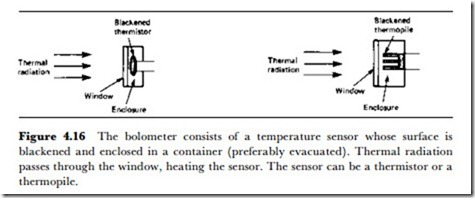Radiant heat energy sensing
Radiant energy, which can be light, heat, radio waves or, in some instances, ionizing radiation, may need to be sensed, and a very large range of the electromagnetic spectrum is sensed by its temperature effect. The sensors for light have mainly been dealt with in the previous chapter, but there is one device, the boLometer, which has been held over to this chapter because its action is essentially thermal.
The bolometer principle is illustrated in Figure 4.16. A blackened material will absorb radiation well and so its temperature will rise when radiated energy falls on it. The change of temperature is then detected in the ways that have been described earlier in this chapter. The classic types of bolometers used in the nineteenth century were metal, and the effect of the temperature rise due to radiation was detected in sensitive measuring bridge circuits. Because the change of temperature due to radiated energy can be small, and the change of resistance correspondingly smaller, bolometers are usually connected into bridge circuits so that the output from an unradiated bolometer can be compared with the output from the bolometer which is deliberately exposed to radiation.
Modern bolometers can make use of semiconductor sensors, blackened for maximum absorption of radiation. The much greater change of resistance
of a thermistor for a small change of temperature makes this type of material ideal for bolometer use and permits much more sensitive detection than was possible with the older types. The non-linear nature of the thermistor is less important in this type of application, because the changes of temperature are usually small.
